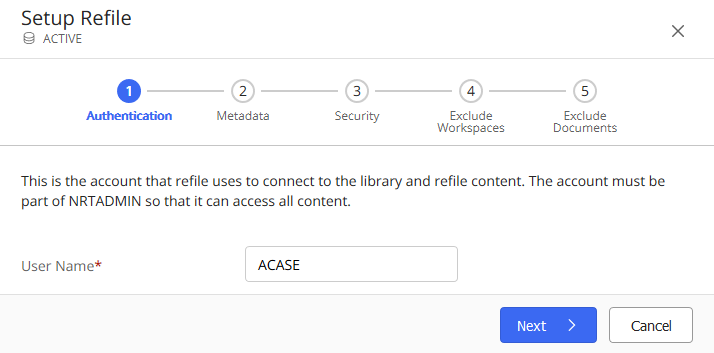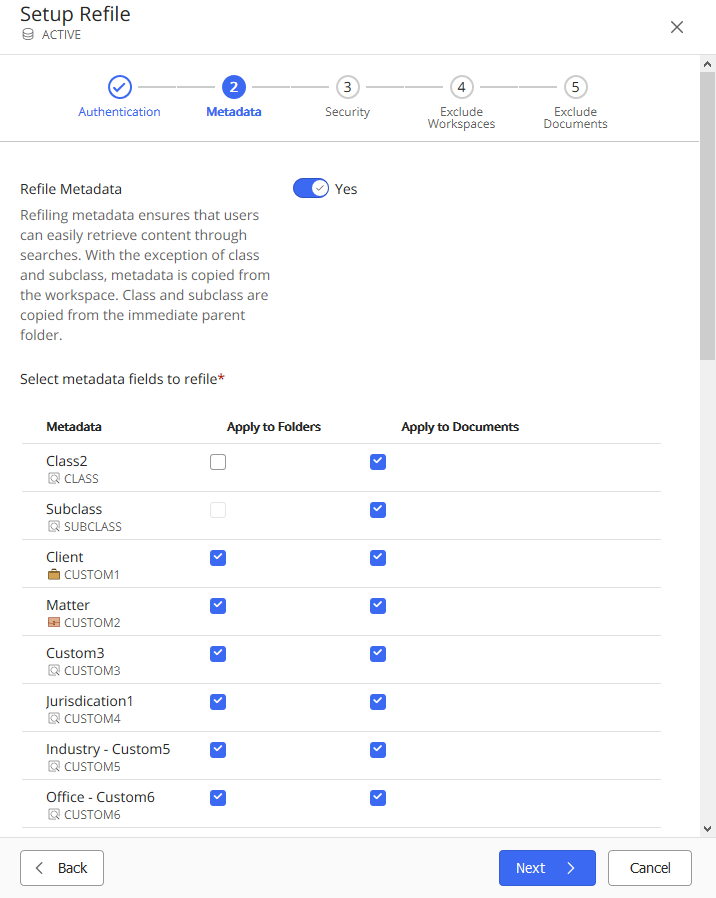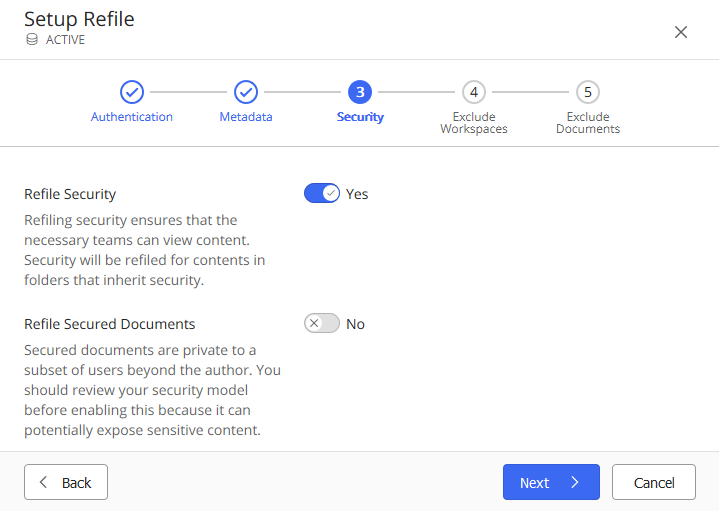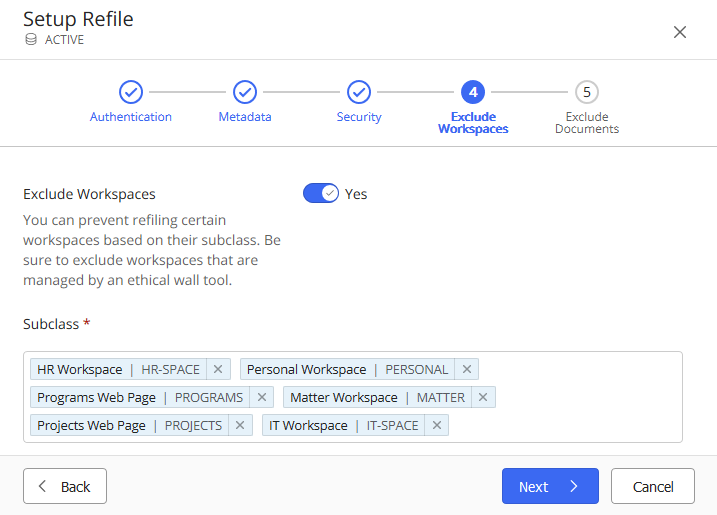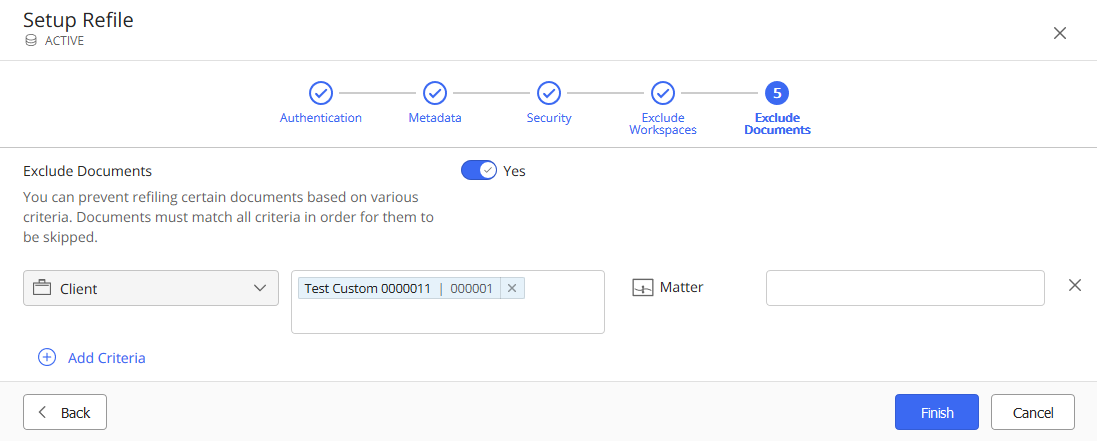Configuring Refile
Navigate to Refile under Settings to see the list of libraries available for refile configuration . If refile configurations are set for a library, the details are displayed in each column. Otherwise, a (--) symbol is displayed, which means refile has not been configured for that particular library.
Select a library from the list that you wish to configure. A page to configure refile settings appears.
Click Configure Refile to configure the following refile settings for the first time. If the library is already configured, on selecting a library from the drop-down list opens the page to edit configuration.
Table: Refile configurations
Expand TableRefile settings
Configuration details
Authentication
Configure the account that refile will use to connect to the library, and refile the content. This account must be part of NRTADMIN so that it can access all the content in iManage Work.
Figure: Authentication
Metadata
Figure: Metadata setup
Set Refile Metadata to Yes to enable metadata refiling. This option is enabled by default.
For document refile, the fields that are selected by default are: Custom1, Custom2, Class, and Subclass.
For folder refile, the fields that are selected by default are: Custom1, and Custom2.
Select the fields you wish to refile for folders and documents. The fields available are: Class-Subclass, and Custom1-30.
Security
Figure: Security setup
Set Refile Security to Yes to enable security refiling. This option is enabled by default.
If you select Yes in the previous step, the Refile Secured Documents option is displayed. This option is disabled by default.
Select Yes to refile secured documents. See Restricted and secured documents for more information.
CAUTION:
You should review the security model of your organization before enabling refile for secured documents, as it could potentially expose sensitive content.
Exclude Workspaces
Figure: Exclude Workspaces
You can configure the Refile Service to exclude certain workspaces based on their subclass.
Important
Be sure to exclude workspaces that are managed by an ethical wall tool. Workspaces with ethical walls can cause performance impacts. This occurs when the security on content is modified by the Refile service, which triggers the ethical wall tool to update the security back to its original setting, which in turn triggers the Refile service again, causing a loop of operations on the workspace.
Set Exclude Workspace to Yes to exclude certain workspaces from refiling. This option is disabled by default.
Enter one or more subclasses to exclude. Refile skips all the workspaces associated with these subclasses.
Exclude Documents
Figure: Documents
You can prevent refiling certain documents based on various criteria. Documents must match all criteria in order for them to be skipped.
Set Exclude Documents to Yes to exclude certain documents from refiling. This option is disabled by default.
Select Add Criteria to define which documents to exclude.
Click Finish to complete refile configuration for a library.
Key concepts to know for refile
Versions: When an item is refiled, all versions of the item are refiled, not just the latest version.
Default security: This is the set of security settings (Public, Private, and View) defined for each item, such as a workspace, folder, or document. The default security settings can be set manually for each item, or, as a best practice, set at a higher container, such as a workspace. Settings from a higher level container will attempt to propagate downward to children containers and documents.
Effect of changing document security or metadata: Changing a document's default security, the ACL, or metadata does not trigger a refile event. Only moving or copying a document is when a document action triggers a refile event.
However, a document that is not secured can have its default security, ACL, or metadata changed by a subsequent refile event, thus overwriting your changes to the document's security. For example, you set a document's default security to View. Later, another user changes its parent container's default security to Public. The change to the parent container triggers a security refile, and the resulting security refile event will overwrite the document's default security to Public.
Moving or copying secured document: If moving or copying a secured document, whether by itself or included in another container, it is possible that the default security changes. For details, see Refile rule to copy or move a container or document. If it is intended that the document remains secured or retains a user access limitation after a copy or move, we recommend the best practice of marking that condition at a higher level, such as at the workspace level, rather than at the document level. For example, if user USER1 is to have No Access on a document at all times, add user USER1 as No Access in the workspace, both for its current location and the target location. After the copy or move, the document will inherit No Access from the workspace for USER1.
Reassigning default security and ACLs: The three conditions that can change an item's default security or its ACLs during a security refile are moving or copying the item, or enabling Refile Secured Documents. In these cases, an item's default security and its ACL change in the following way:
The existing default security is removed.
The ACL is cleared.
The default security is set from the parent container.
The ACL is set from the parent container.
For example, a document whose default security is View and the ACL includes only user John with Read/Write access is being moved to a container whose default security is Public and the ACL includes only user Chris with Full Access. The result of the move is that the document's default security and ACL is cleared (and therefore user John is not included in the ACL anymore). Its new default security is set to Public, and user Chris is added to the ACL and granted Full Access. John has Public access but not explicitly through the ACL but as any user with Public access. Care must be taken as this may mean existing users and their access can be removed or changed, and/or users from the parent container may be added to the item. This is an exception to the rule that a user with No Access will never be elevated due to a refile event. See the User No Access Level Never Elevated rule on the Refile rules page.
Skipped Items: Once refile determines that a container is to be skipped, no further processing occurs within that item. This means that if a container is determined to be skipped, all items inside that container, including other containers and documents, are also skipped.





